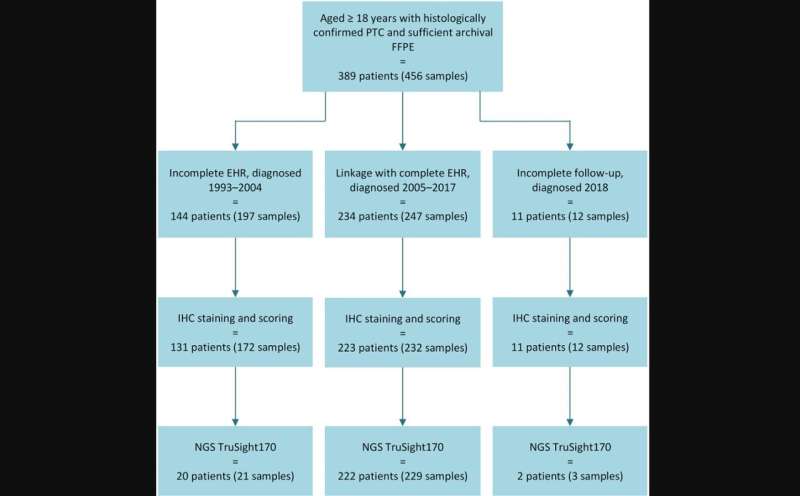This article has been reviewed according to Science X's editorial process and policies. Editors have highlighted the following attributes while ensuring the content's credibility:
fact-checked
proofread
NTRK gene fusion in papillary thyroid cancer: A clinicogenomic biobank and record linkage study

A new research paper was published in Oncotarget, titled, "Neurotrophic-tyrosine receptor kinase gene fusion in papillary thyroid cancer: A clinicogenomic biobank and record linkage study from Finland."
Selective tropomyosin receptor kinase (TRK) inhibitors are approved targeted therapies for patients with solid tumors harboring a neurotrophic tyrosine receptor kinase (NTRK) gene fusion. Country-specific estimates of NTRK gene fusion frequency and knowledge of the characteristics of affected patients are limited.
In this new study, researchers Wei Zhang, Arndt A. Schmitz, Roosa E. Kallionpää, Merja Perälä, Niina Pitkänen, Mikko Tukiainen, Erika Alanne, Korinna Jöhrens, Renate Schulze-Rath, Bahman Farahmand, and Jihong Zong from Bayer HealthCare Pharmaceuticals Inc., University of Turku, Turku University Hospital, Technical University Dresden, and Western Finland Cancer Centre identified patients with histologically-confirmed papillary thyroid cancer (PTC) from Finland's Auria Biobank.
"The study objectives were to determine the frequency of NTRK gene fusion in patients with PTC in Finland and to describe co-occurring genetic alternations, clinical characteristics, disease progression, and treatment pathways in NTRK gene fusion-positive patients," write the researchers.
TRK protein expression was determined by pan-TRK immunohistochemistry. Immuno-stained tumor samples were scored by a certified pathologist. Gene fusions and other co-occurring gene alterations were identified by next-generation sequencing. Patient characteristics and vital status were determined from linked hospital electronic health records (EHRs).
Patients were followed from 1 year before PTC diagnosis until death. 6/389 (1.5%) PTC patients had an NTRK gene fusion (all NTRK3); mean age 43.8 years (and none had comorbidities) at PTC diagnosis. Gene fusion partners were EML4 (n = 3), ETV6 (n = 2), and RBPMS (n = 1). Of 3/6 patients with complete EHRs, all received radioactive iodine ablation only and were alive at end of follow-up (median observation, 9.12 years).
"In conclusion, NTRK gene fusion is infrequent in patients with PTC. Linkage of biobank samples to EHRs is feasible in describing the characteristics and outcomes of patients with PTC and potentially other cancer types," the authors write.
More information: Wei Zhang et al, Neurotrophic-tyrosine receptor kinase gene fusion in papillary thyroid cancer: A clinicogenomic biobank and record linkage study from Finland, Oncotarget (2024). DOI: 10.18632/oncotarget.28555



















